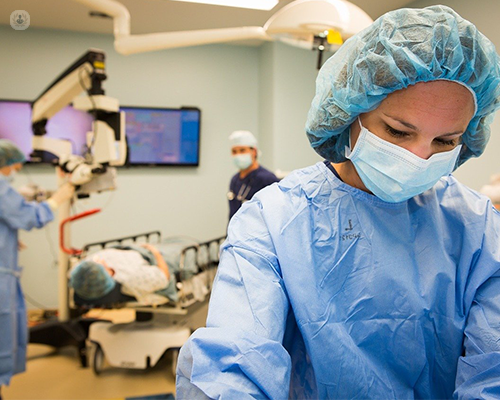What to expect from orbital decompression surgery and recovery
Written by:Orbital decompression surgery is a major eye surgery. However, the surgery can be vital for those with severe symptoms caused by thyroid eye disease (TED).
Miss Kimia Ziahosseini has performed several orbital decompression surgeries for TED (thyroid eye disease) patients and guided them through recovery. In this article, she talks you through the surgical and recovery processes. See her explanation of TED and its treatment for even more professional insight.

What’s the purpose of orbital decompression?
Orbital decompression surgery is used to relieve orbital pressure. It increases the space available for the interior parts of the eye, which means it can settle into a more relaxed and normal position in the eye socket. Occasionally, the optic nerve may be compromised by high orbital pressure. In such patients, orbital decompression increases blood perfusion (the passage of blood through the circulatory system) and saves eyesight.
Is anaesthetic used for orbital decompression surgery?
General anaesthesia is used during orbital decompression surgery. This means that as you undergo the procedure, you won’t be conscious.
Is orbital decompression a long surgery?
The amount of surgery needed can vary from patient to patient: it depends on how severe your eye condition is and how severe the level of proptosis (bulging eyes) is.
Where is the incision made?
An incision is made within the conjunctiva (the thin layer that lies over the white part of the eye) on the inside of the eyelids. Alternatively, the incision can be made in skin creases in the eyelids to hide or camouflage surgical scars.
How long are patients in the hospital after surgery?
Generally, patients stay in the hospital for a day or two after the procedure. Then they can be discharged.
How long does it take to recover from orbital decompression surgery?
The scale of surgery should not be judged by the small incisions involved. Although the skin incision settles over a few weeks, natural repair of the deeper tissues can take many months and accounts for occasional deeper ache or discomfort during this healing phase. Swelling and some bruising of the eyelids can develop in the week following surgery, and this swelling can take a few months to settle completely.
Double vision (diplopia) might occur or worsen during this healing period. In some cases, it requires surgery to re-align the eyes. Thus, driving and working following surgery might be delayed by several weeks, and this should be taken into account when planning treatment.
What are the possible complications of orbital decompression?
As with all surgery, there are typical possible side effects:
- Infection
- Scarring
- Swelling
Specific possible side effects of orbital decompression surgery can include:
- A decline in vision
- Double vision (diplopia)
- A change in lid height or position
Some surgeons routinely create a window in the outer wall of the eye socket (lateral wall decompression). This effectively creates a window to the muscles of the temple. In our experience, this can cause hollowness over the outer sides of the eye sockets and give a sensation of eye movement upon chewing. It is our practice to keep a thin wall of bone intact to prevent these problems.
With decompression of the orbital floor (this being undertaken in patients with more severe proptosis and when the medial or lateral wall decompression extends to the floor), numbness over the upper cheek and upper front teeth can occur , and in the great majority of patients (over 90 per cent), this recovers completely.
All forms of decompression surgery carry a risk of permanent visual loss. However, the risk of this (per eye) is in the region of 1 in 1000. In patients with visual loss before surgery, visual recovery may be incomplete.
With all surgery, there remains a minute risk of neurological injury, and indeed to life itself, this being either due to anaesthesia, surgery, or a combination of both.
As with all surgery, the possible risks versus the benefits are very carefully considered for each and every patient before surgery is arranged.
What happens after orbital decompression?
Once you have fully recovered from orbital surgery, your oculoplastic surgeon will discuss further surgery if necessary.
Squint surgery (if necessary)
This may be squint surgery to the muscles that control the eyes to resolve or reduce double vision. Sometimes, more than one squint surgery may be necessary and sometimes incorporating prisms into your glasses may be necessary to completely resolve the double vision if this cannot be fully achieved with surgery. Squint surgery for thyroid eye disease requires general anaesthesia, but occasionally it can be done under local anaesthesia with sedation if general anaesthesia is not an option.
There is a very small likelihood of reactivation of thyroid eye disease after squint surgery and you must take measures to ensure your thyroid function remains stable for good and avoid smoking.
Eyelid surgery (if necessary)
Once you have recovered from the squint surgery or if you do not need it in the first place, you may require surgery on your eyelids. This is often in the form of lowering the upper eyelids with a type of blepharotomy procedure. This is best done under local anaesthesia with sedation so that the effect of surgery can be graded during the operation to achieve the best outcome.
Learn how you can benefit from Miss Kimia Ziahosseini’s highly professional and personalised patient care – visit her profile.


